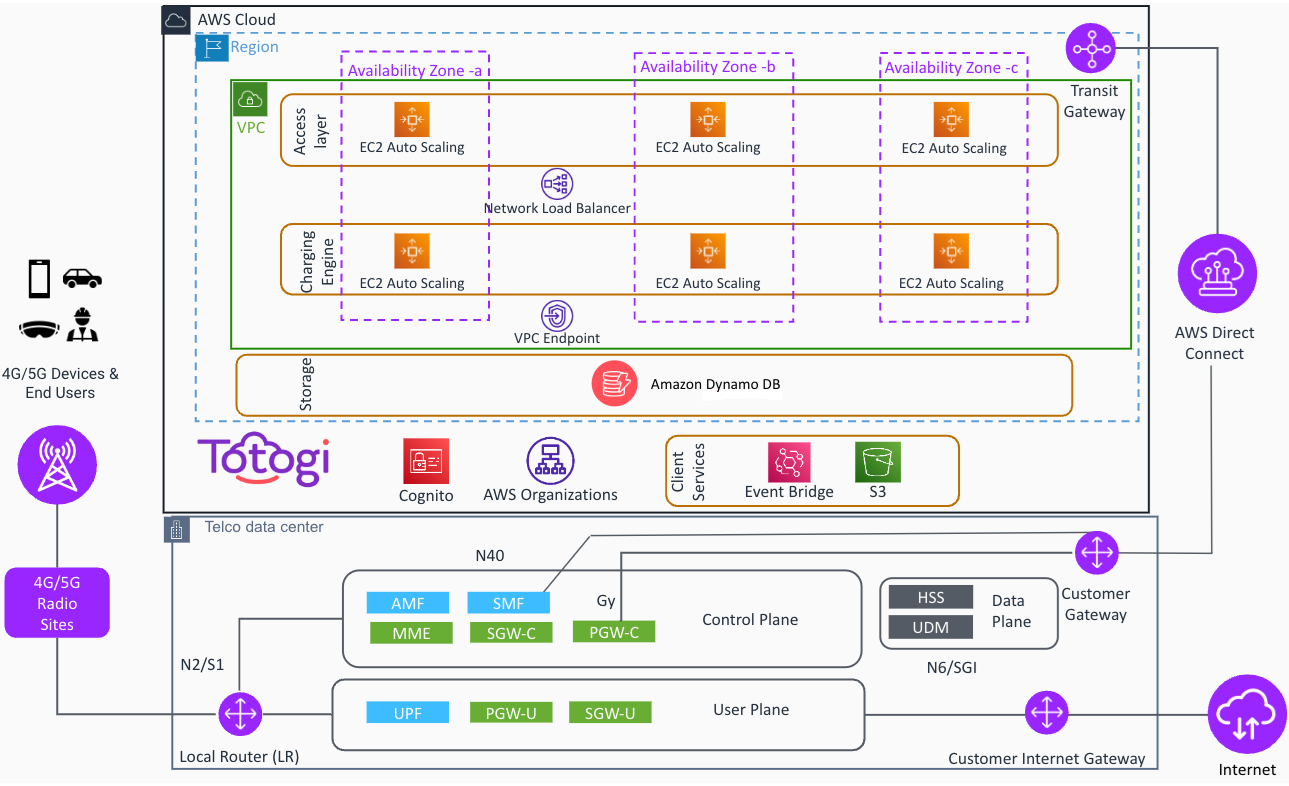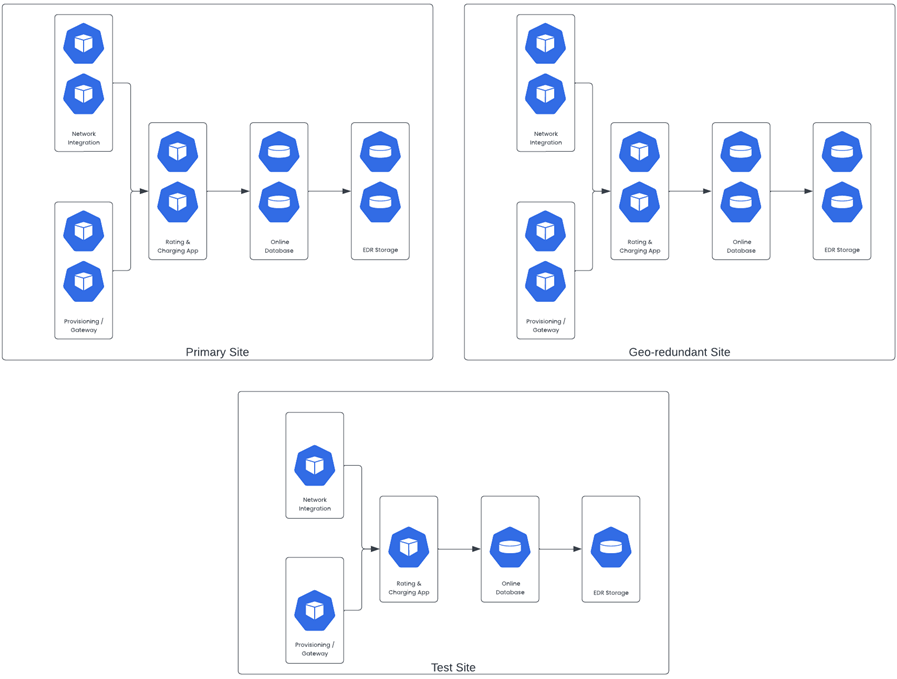AWS Partner Network (APN) Blog
Reducing the Carbon Footprint of Mobile Network Operations Using Totogi’s Charging-as-a-Service Platform
By Marc Breslow, Field CTO – Totogi
By Nicolai van der Smagt, Sr. Solutions Architect, Telco – AWS
 |
| Totogi |
 |
Climate change is one of the greatest threats humanity has faced, and the mobile industry has a role to play in fighting this global crisis.
According to a recent report from the GSMA Climate Action Taskforce, the mobile industry is responsible for emissions of around 490 million tonnes of carbon dioxide equivalent (MtCO2e) per year, or approximately 1% of total global carbon emissions in 2021. This includes emissions from mobile operators’ entire operations, fixed networks, and data centers.
Mobile network operators are aware of their responsibility and have taken action—46% of the industry (measured by number of connections) has committed to a science-based target of rapidly decreasing their direct and indirect emissions by 2030, while 39% have committed to a net-zero target by 2050 or earlier. Electricity efficiency is an important factor in achieving these targets.
While the mobile radio access network (RAN) is by far the largest electricity consumer in mobile networks, it’s estimated that data centers hosting operators’ IT and operations and business support systems (OSS/BSS) emitted some five million tonnes of CO2e in 2022. Optimizing these emissions will greatly help operators achieve their emissions target and contribute to limiting global warming to 1.5°C, as set out in the Paris agreement.
Totogi is an AWS Partner and AWS Marketplace Seller that provides a Charging-as-a-Service platform that benefits from deployment on Amazon Web Services (AWS) and helps customers reduce the electricity used for their online charging system.
In this post, we’ll compare the Totogi charging platform’s energy and carbon-emissions efficiency to traditional charging platforms—and investigate architectural patterns that telcos and other businesses can replicate to reduce their carbon footprint.
Totogi Platform Overview
Totogi is transforming the telecommunications BSS landscape as the first genuinely cloud-native, multi-tenant charging platform, designed to operate as a software-as-a-service (SaaS) solution on AWS.
By leveraging artificial intelligence (AI) and machine learning (ML)-based services, Totogi unlocks the potential of data owned by telcos, empowering them to harness valuable network insights that can be used to generate personalized and innovative offers automatically and deepen customer relationships.
Totogi’s unique design contributes to climate change mitigation through reduced operating costs. Its 4G and 5G converged charging service (CCS) can significantly decrease your total cost of ownership (TCO) by more than 50% compared to single-instance private cloud or on-premises deployment scenarios.
To achieve TCO advantages, Totogi’s platform offers:
- Multi-tenancy: Eliminates the need for dedicated infrastructure by creating your tenant within a shared environment.
- Scalability: Accommodating newly-established telcos with no subscribers and seamlessly expanding to support millions of subscribers.
- Efficiency: Ensures operational costs scale linearly with the number of end users.
- Flexible pricing: Features a free tier for up to 500 million transactions per month (about 250,000 subscribers), enabling telcos to adopt a pay-as-you-grow approach.
Designed for AWS
Distinct from traditional charging platforms weighed down by technical debt and high management and customization expenses, Totogi’s platform is built for the future.
Harnessing the power of AWS, Totogi Charging-as-a-Service boasts enhanced security, performance, reliability, and sustainability. It’s built on autoscaling AWS primitives like Amazon DynamoDB, which enables optimal utilization of the underlying infrastructure and dynamic adjustment of capacity to match current demand. It comes with high availability and load balancing across three AWS Availability Zones (AZs).
Test environments separate Totogi tenants in the multi-tenant platform. If you’re using Totogi’s SaaS CCS, there’s no need to add physical or virtual servers to your inventory. Instead, you utilize a shared service via APIs that is logically partitioned to support hundreds of telcos on the same platform.
The core of Totogi’s architecture is simple. It uses DynamoDB with single-table design for persistent data storage, stateless charging engines deployed into Amazon Elastic Compute Cloud (Amazon EC2) auto scaling groups for the core application, and protocol-adapters deployed as a second auto scaling group to provide Diameter support in addition to the 5G Nchf REST services.
AWS-managed Application Load Balancers distribute connections evenly across the services running in each auto scaling group and ensure the service is appropriately provisioned to handle transaction loads at any point in time.
As shown in Figure 1, interactions with the Totogi service are managed through APIs–3GPP APIs like Diameter Gy and 5G REST N40, as well as GraphQL APIs for activities like provisioning subscribers and retrieving event detail records (EDRs).
While recent EDRs are available online by API calls, they are also propagated to Amazon Simple Storage Service (Amazon S3) where they are kept as long as your retention policies require. Amazon S3 is infinitely scalable and provides features like intelligent tiering that allow developers to delegate management of hot/fast online storage vs. delayed-access yet equally resilient cold storage.
Figure 1 – Multi-tenant Totogi architecture.
Challenges with Traditional Approaches
Traditional charging systems (deployed in your data center or on your own public or private cloud infrastructure) require dedicated infrastructure to meet the reliability requirements of a network. While the architectures vary from vendor to vendor, the pattern is generally the same:
- Rating and charging application servers.
- High-performing online database servers.
- Long-term EDR storage servers.
- Provisioning management servers.
- Access-layer servers for network integration.
Because CCS is such a mission-critical system for telcos, you need to deploy with a base amount of redundancy. You’ll typically have at least two of each server for high availability, an environment for disaster recovery, and one or more test environments.
The footprint for a charging system installation can easily require 25 servers regardless of your true needs or scale, and the minimum provisioned capacity can be as high as 10-15M subscribers, even though you may not have that many potential customers in your market. That’s a lot of wasted capacity and, unfortunately, a lot of wasted energy.
Figure 2 – Single-tenant deployment footprint – Indicative CCS installation.
Totogi’s alternative, multi-tenant approach provides the same redundancy and quality of service required of mission-critical telco-grade software, yet meets your capacity needs where they are.
Instead of replicating the same infrastructure stack and deploying infrastructure replicas for every telco customer, Totogi securely shares the same underlying resources across its customers in a similar fashion to how Stripe and Salesforce serve multiple customers with the same underlying infrastructure.
More Sustainable on AWS
By deploying your BSS on AWS, mobile operators can reduce their carbon footprint. Amazon is the largest corporate buyer of renewable energy in the world, and studies by 451 Research have shown that AWS’s infrastructure is 3.6 times more energy efficient than the median of U.S. enterprise data centers surveyed and up to five times more energy efficient than the average in Europe.
451 Research also found that AWS can lower customers’ workload carbon footprints by nearly 80% compared to surveyed enterprise data centers, and up to 96% once AWS is powered with 100% renewable energy—a target AWS is on path to meet by 2025.
So, just by deploying on AWS, Totogi has drastically reduced the carbon footprint of its BSS. System architecture and sustainable design choices play an important part in that reduction, too.
Energy Efficiency Through Higher Utilization
Compute services make up the foundation of BSS workloads. When you look at the energy proportionality of hardware (the ratio between consumed power and utilization), an idle server still consumes power, as shown in The Case for Energy-Proportional Computing.
Workload efficiency can be improved by using the fewest number of compute resources and achieving a high utilization—this is what Totogi achieves with its multi-tenant architecture. The infrastructure is deployed on AWS just once, to serve many users. That way, Totogi leverages economies of scale to achieve high utilization rates, while still providing optimal performance and security.
Various studies (Data Center Efficiency Assessment / Data Center IT Efficiency Measures) put the average server utilization rate in on-premises data centers somewhere between 6-25%, and it’s estimated that a quarter of data center servers and a third of virtual machines running on them are “comatose,” meaning they have seen no activity for six months or longer but were never decommissioned.
Anecdotal evidence from one of Totogi’s telco customers shows that its platform (scaled for 10,000 transactions per second /10 million subscribers) runs at an average 33% utilization rate.
Totogi’s SaaS solution on AWS has a higher utilization rate, and thus better energy efficiency. The EC2 instances Totogi uses for the access layer and charging engine use auto scaling to ensure the available compute capacity in those functions closely follows actual demand of Totogi’s customers, leading to actual CPU utilization of 73% (while managing 5,000 transactions per second).
Figure 3 – Server utilization in Totogi’s auto scaling groups.
Totogi also uses AWS managed services in many places. For example, Amazon DynamoDB in auto-scaling provisioned mode is the primary datastore; Amazon S3 with intelligent tiering is used for EDR storage; Amazon EventBridge is utilized for asynchronous integrations; and AWS Lambda and AWS AppSync are used for CRUD APIs.
With managed services, AWS is responsible for optimizing the utilization rate of the underlying infrastructure. AWS has a huge scale advantage, allowing Totogi to build intelligent automation to drive up utilization rates in managed services, as well as many thousands of customer workloads to fit optimally to the available underlying infrastructure.
Sustainable Architecture Choices
Energy efficiency is not just about utilization, and Totogi’s compute tier exclusively uses AWS Graviton2 wherever possible. Graviton2 processors are designed by AWS to deliver the best price performance for your cloud workloads—up to 2-3.5 times better CPU performance per watt than any other processor in AWS.
Additionally, Graviton2 provides up to 40% better price performance over comparable current generation x86-based instances for various workloads. With Graviton2, Totogi has built a frugal system that uses less electricity per BSS request.
Other key areas where Totogi has designed the platform for lower carbon footprint are storage, operations, and location. Totogi compresses customer data it stores (such as EDRs on S3) in order to reduce required storage volume. Meanwhile, AWS focuses on optimizing the utilization of storage hardware and software underpinning S3.
Other energy optimizations that Totogi has made include:
- Scheduling background jobs like synchronizing data between datastores to happen at a level pace to avoid usage spikes that could cause auto scaling or AWS to provision additional electricity-consuming resources.
- Running in AWS regions powered with the highest percentage of renewable energy (95% in 2021).
Conclusion
As a contributor to climate change, mobile network operators are taking responsibility. Totogi provides a new breed of business support systems that it offers in a SaaS model on AWS, with significant carbon footprint advantages compared to traditional self-managed/self-hosted platforms.
Operators that leverage Totogi’s Charging-as-a-Service platform get access to a reliable and scalable platform that’s continuously being improved and augmented with additional innovations and provides a pay-as-you-grow approach. They also benefit from the clear carbon advantage of the platform and are able to reduce their overall carbon footprint that way.
Learn more about Totogi in AWS Marketplace.
Totogi – AWS Partner Spotlight
Totogi is an AWS Partner that provides a Charging-as-a-Service platform that benefits from deployment on AWS and helps customers reduce the electricity used for their online charging system.



